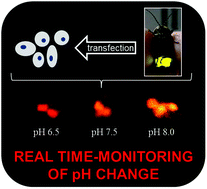Novel application of Macrolampis sp2 firefly luciferase for intracellular pH-biosensing in mammalian cells
Abstract
Bioluminescence is widely used in biosensors. Firefly luciferase-based bioluminescent sensors are among the most popular ones. Firefly luciferases are pH-sensitive, displaying a large red shift at acidic pH, a property that has been considered undesirable for most applications. Currently, biosensors that can detect intracellular pH are in demand, and some fluorescent biosensors are available. However, pH sensors using bioluminescence have not been used yet. Thus, we decided to harness a firefly luciferase to measure the intracellular pH in mammalian cells. For this purpose, we engineered the luciferase derived from Macrolampis sp2 firefly to localize it on the cytosol or nucleus, in order to observe pH variation in these compartments during biological activities. We first calibrated the emission ratios (R = Igreen/Ired) at different pH values. As expected, we observed a red shift of light emission under acidic conditions when the cells were subjected to different pH conditions in the presence of the K+/H+ ionophore, nigericin. Based on these results, we concluded that this firefly luciferase can be used as a diagnostic tool for measuring the intracellular pH variation in pathogenic cells or in cells during apoptosis. This is the first example of real time-monitoring of pH change using color tuning luciferase.



 Please wait while we load your content...
Please wait while we load your content...